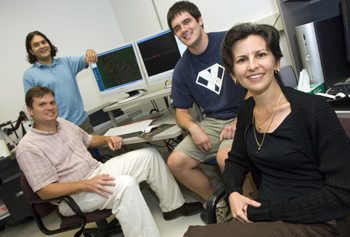
Alissa Weaver, M.D., Ph.D., right, with members of her research team, from left, Scott Guelcher, Ph.D., Aron Parekh, Ph.D., and Kevin Branch. (photo by Dana Johnson)
Rigid surroundings may help promote aggressive cancers
Dense, rigid surroundings make cancer cells antsy.
They step up their invasive activities, building more drilling structures — called invadopodia — and boring into the matrix around them, Vanderbilt-Ingram Cancer Center investigators report in the Sept. 9 issue of Current Biology.
The findings offer a cellular explanation for an observed correlation between human breast tissue density and tumor aggressiveness, said Alissa Weaver, M.D., Ph.D., assistant professor of Cancer Biology and lead author of the study. Women with increased breast density on mammograms have an increased risk for both developing breast cancer and having breast cancers with invasive characteristics.
This connection between breast density and cancer aggressiveness has raised the question of which comes first. Is the tissue denser because the tumor is more aggressive (and recruits cells that “lay down” more matrix), or is the tumor more aggressive because the tissue is denser?
“Our study shows that if you have a dense, rigid matrix, the cells will be more aggressive and invasive; it's a direct effect,” Weaver said.
Weaver and colleagues were interested in invadopodia — the finger-like protrusions that a cancer cell uses to drill holes in the extracellular matrix (matrix-degrading enzymes are associated with invadopodia). These structures are believed to be important for cancer invasion.
“If you have enough invadopodia, over time they'll make large holes that cells can move through to invade and metastasize,” Weaver said.
Despite the intimate connection between invadopodia and the matrix, very little was known about what role the matrix might play in regulating invadopodia function. Weaver and colleagues started probing this question as part of a computational math modeling project through the Vanderbilt Integrative Cancer Biology Center.
They were surprised to find that breast cancer cells cultured on a denser — and thus, more rigid — matrix had a greater number of active invadopodia than breast cancer cells cultured on a less dense matrix.
“We thought that more 'stuff' for the cells to get through was going to make it harder, so we expected to see less matrix degradation, but instead we found this interesting effect where cells actually sense the rigidity and degrade more,” Weaver said.
The team examined how cells convert a sense of matrix rigidity into intracellular signals, a process called mechanotransduction.
Proteins that generate contractile forces, such as myosin “motors,” are important players in mechanotransduction. Weaver and colleagues confirmed that myosin motors are involved in sparking more degradation by invadopodia in response to a rigid matrix, though the motors themselves are not present in the drilling structures.
The investigators also implicated the activities of two signaling proteins called FAK and p130Cas in the rigidity-induced invadopodia activity. These signaling proteins were present in an activated state in the invadopodia, suggesting that they are important players in this response and may represent targets for anti-invasive therapies.
Weaver said that it's exciting to find a cellular mechanism that could explain why denser breast tissue is correlated with more aggressive tumors and a poorer prognosis for patients.
“The idea that tissue rigidity leads to a more aggressive phenotype had been out there for a while,” she said, “but it hadn't actually been tied to matrix degradation, which is thought to be important for metastasis and spread of cells through the body.”
Because metastasis is often what makes cancers deadly, new leads on how to block it are critical, she added.
Nelson Alexander, Ph.D., Kevin Branch, Aron Parekh, Ph.D., Emily Clark, Ph.D., and Izuchukwu Iwueke, in the Department of Cancer Biology at Vanderbilt, and Scott Guelcher, Ph.D., in the Department of Chemical Engineering at Vanderbilt, contributed to the studies. The National Institutes of Health and the Vanderbilt University School of Engineering supported the research.













